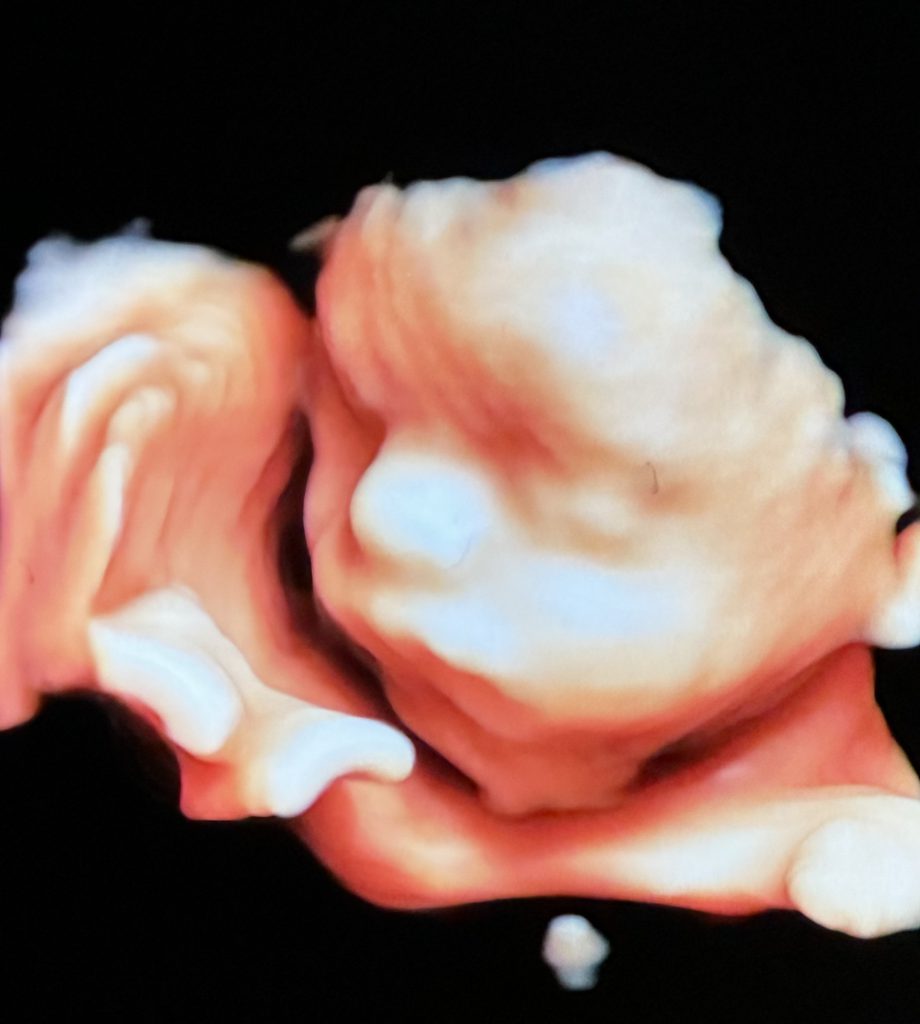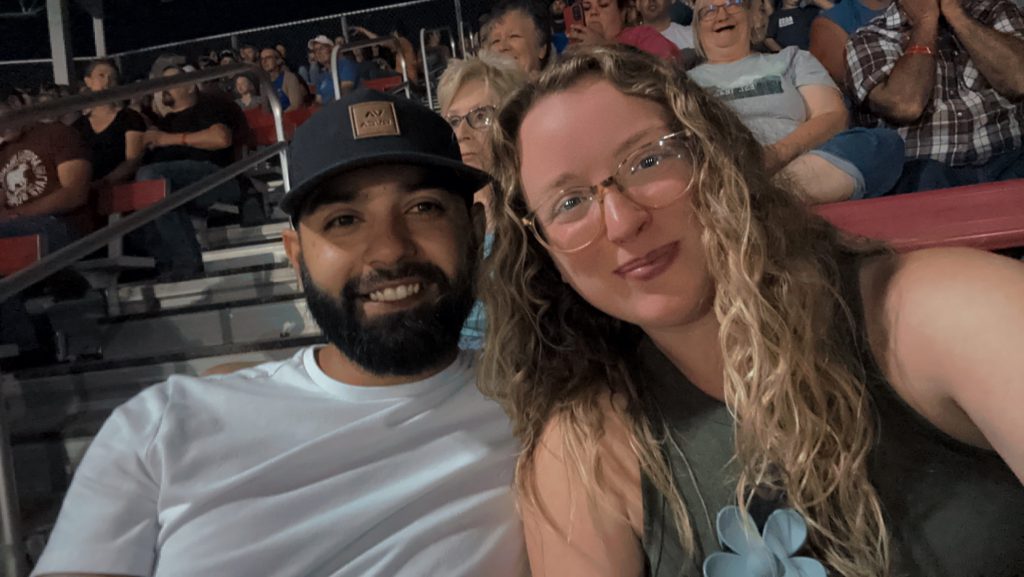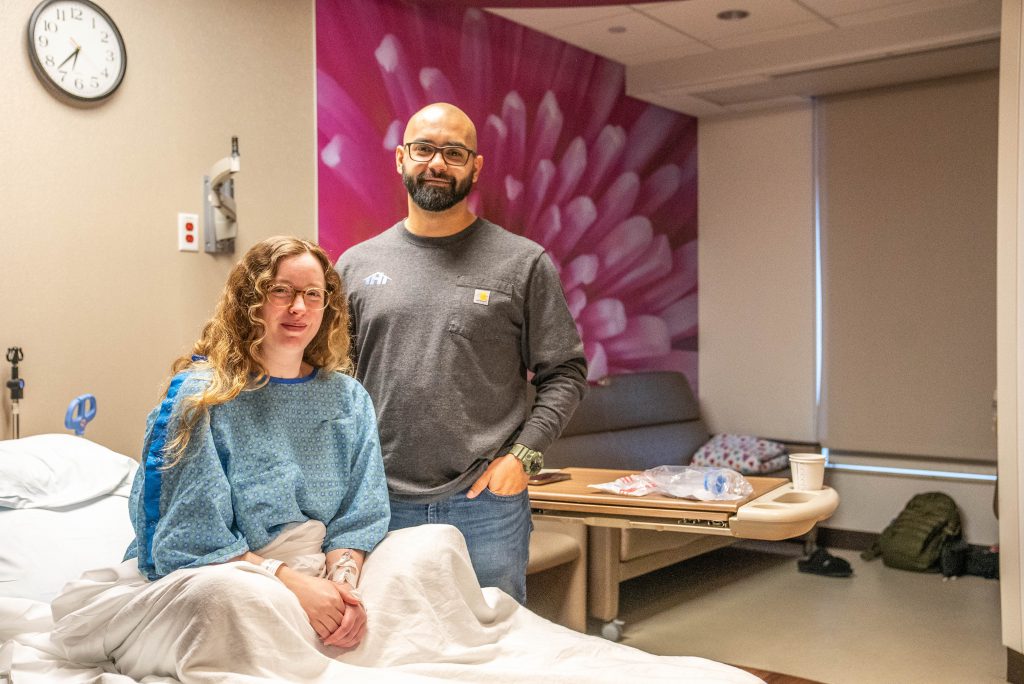The following blog contains photos of the patient family’s fetal spina bifida repair procedure
On a brisk March morning in 2024, Elizabeth Hansen and her husband, Chris, nervously woke up in Minneapolis rather than their own bed more than 240 miles away in Des Moines, Iowa. For Elizabeth, a middle school English teacher, the pre-dawn nerves were not the typical anxious butterflies before the first day of school. Instead, this 4 a.m. wake-up call marked the morning she and her unborn son, Santiago, would undergo surgery to repair the little one’s severe spina bifida before his June due date.
“Ultimately, I just kept praying that Santiago would handle the surgery well and that he would be able to stay inside the womb as long as possible after the operation,” Elizabeth recalled.
Baby Santiago’s delicate in-utero spina bifida repair procedure would be the 100th performed at the Midwest Fetal Care Center, a collaboration between Allina Health and Children’s Minnesota.
Discovering Santiago’s spina bifida
Elizabeth first learned about her son’s serious diagnosis during an anatomy scan in Des Moines 18 weeks and 5 days into what was already considered a high-risk pregnancy.
“We went in excited to find out if our baby was a boy or a girl, and the appointment quickly turned into multiple people looking at the ultrasounds and my referring doctor came in and diagnosed Santiago,” Elizabeth explained.
Elizabeth and Chris learned Santiago had a severe form of spina bifida called myelomeningocele (MMC). If left untreated, Santiago would have been born with no skin covering his spinal cord, nerves, muscles or bone in the area of his back around the MMC. Without the in-utero procedure, he also would have had a small sac containing his spinal cord and nerves projecting out of his lower back.
Babies born with this condition can face numerous health challenges such as swelling of the brain that can lead to diminished neurocognitive function and future brain surgery to correct the swelling. Risks also include hind brain hernia that affect a child’s breathing, swallowing and even heart function.

Babies with MMC have significant challenges with bowel and bladder function and will often have weakness and numbness in their lower extremities. MMC can also leave most babies needing help moving or requiring a wheelchair for the rest of their lives.
“Our doctor who gave us the diagnosis gave us the worst case for our son, and that was all I could focus on until we got more information and answers up in Minneapolis,” Elizabeth said. “Ultimately, all I wanted was for our son to live a fulfilling and meaningful life.”
Chris also reflected on the moment he learned about Santiago’s condition, “I thought, let’s take time to digest the information and not overreact to the unknowns of the moment.”
Arriving at the Midwest Fetal Care Center
Elizabeth was quickly referred to the Midwest Fetal Care Center (MWFCC) inside Children’s Minnesota in Minneapolis. There, the young family met with a multi-disciplinary team of highly trained maternal-fetal medicine experts, including Dr. Cliff Brock and Dr. Joe Lillegard, the head of open fetal surgery at the MWFCC.
“Everyone was great with answering our questions and making sure that we fully understood our son’s diagnosis,” Elizabeth said. “I did find it comforting that everyone that would be involved in this journey was under one roof and they seemed to mesh well.”
Elizabeth, Chris and their MWFCC team decided the best course of action would be a fetoscopic MMC repair procedure. Dr. Lillegard would use a small camera, called a fetoscope, to see inside Elizabeth’s uterus to safely repair Santiago’s spina bifida.
“I had no doubt in my mind that this was the best chance to give our son,” Elizabeth said.
Surgery day
The day for Elizabeth’s early morning March surgery had come 25-weeks into her pregnancy – the ideal timeframe to do the procedure. After making an abdominal incision to expose Elizabeth’s uterus and positioning Santiago to allow access to his back, Dr. Lillegard made three, 5-millimeter incisions in Elizabeth’s uterus. The surgeon then inserted the fetoscope camera through one incision. Using the fetoscope to see Santiago’s spine, Dr. Lillegard used “micro” surgical instruments inserted through the two other incisions to repair the unborn child’s spina bifida.
Inside the operating room, a large team of experts including Dr. Brock; Dr. Saul Snowise, medical director of the MWFCC; pediatric surgeon Dr. James Fisher; neurosurgeon Dr. Amy Bruzek and a group of specially trained nurses and researchers worked in unison with Dr. Lillegard as he operated. Dr. Lisa Howley, medical director of fetal cardiology at Children’s Minnesota, closely monitored the unborn child’s heartrate in real time using special equipment. After about four hours of surgery, Santiago’s procedure was a success – the 100th MMC fetal repair performed at the MWFCC was complete.
“I think it’s incredible to be number 100,” Elizabeth said. “It just made this entire experience a little extra special.”
Continued care
Baby Santiago is due on June 30, 2024. Elizabeth will deliver inside our Minneapolis hospital at The Mother Baby Center, a partnership between Allina Health and Children’s Minnesota. For now, the mom-to-be has weekly ultrasounds and tests to monitor Santiago. Once he’s born, Santiago will be in our neonatal intensive care unit (NICU) until he is ready to go home to Iowa.
“Looking back, I would do this entire process over if I needed to,” Elizabeth said. “Everyone on the team, as well as the nurses at the hospital, have been incredibly helpful and reassuring. I know I am in great hands here.”


